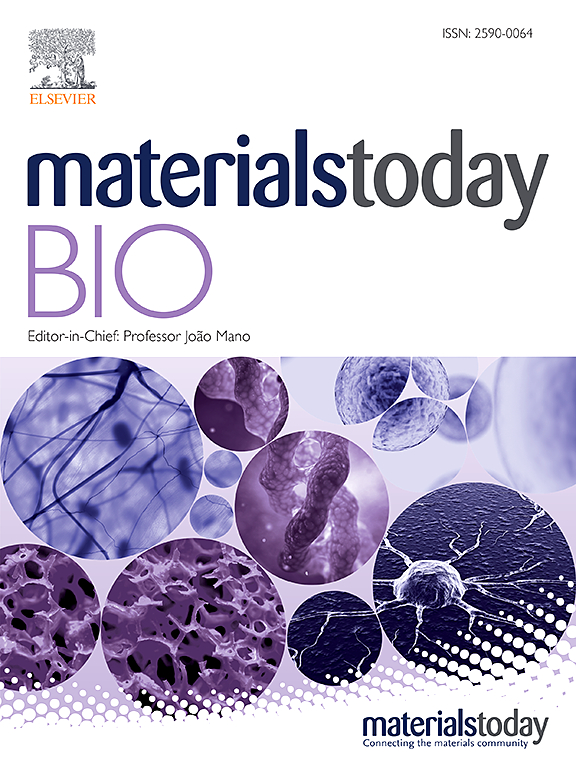黄芪甲苷功能化的超小纳米颗粒调节补体途径,抑制小胶质突触吞噬,减少麻醉神经毒性
IF 8.7
1区 医学
Q1 ENGINEERING, BIOMEDICAL
引用次数: 0
摘要
突触损伤被确定为七氟醚诱导的神经毒性的主要病理,有助于神经行为和神经发育缺陷。神经元突触丢失是通过补体途径介导的小胶质细胞介导的突触吞噬发生的。黄芪苷是一种天然类黄酮化合物,具有抗肿瘤、抗补体、抗炎等多种生物活性。本文中,黄芪甲苷功能化的Cu2-xSe纳米颗粒(CSPA NPs)可以有效抑制补体途径,减轻小胶质细胞介导的突触吞噬,促进突触恢复,以修复七氟醚诱导的神经毒性。它们有效地靶向并减少小胶质细胞的活化和吞噬作用。通过下调sortilin, CSPA NPs增加颗粒前蛋白表达,促进TFEB细胞质易位,降低溶酶体活性和小胶质细胞吞噬。此外,CSPA NPs降低补体C1q和C3水平,抑制小胶质突触吞噬,改善七氟醚处理小鼠的认知功能障碍。本研究表明,CSPA NPs通过补体途径抑制小胶质细胞突触消除,减轻七氟醚诱导的神经毒性,并为治疗补体途径相关疾病提供见解。本文章由计算机程序翻译,如有差异,请以英文原文为准。

Astragalin-functionalized ultrasmall nanoparticles modulate the complement pathway to inhibit microglial synaptic phagocytosis for reducing anesthetic neurotoxicity
Synaptic impairment is identified as a primary pathology in sevoflurane-induced neurotoxicity, contributing to neurobehavioral and neurodevelopmental deficits. Synaptic loss in neurons occurs through microglia-mediated synaptic phagocytosis via the complement pathway. Astragalin, a natural flavonoid compound, exhibits diverse bioactivities, such as anti-tumor, anti-complement, and anti-inflammatory effects. Herein, astragalin-functionalized Cu2-xSe nanoparticles (CSPA NPs) can effectively inhibit the complement pathway, mitigating microglia-mediated synaptic phagocytosis and promoting synaptic restoration to repair sevoflurane-induced neurotoxicity. They efficiently target and reduce microglial activation and phagocytosis. By downregulating sortilin, CSPA NPs increase progranulin expression, promoting TFEB cytoplasmic translocation to decrease lysosomal activity and microglial phagocytosis. Furthermore, CSPA NPs decrease complement C1q and C3 levels, inhibiting microglial synaptic engulfment and ameliorating cognition dysfunction in sevoflurane-treated mice. This study illustrates that CSPA NPs inhibit microglial synaptic elimination via the complement pathway, alleviating sevoflurane-induced neurotoxicity and providing insights into treating complement pathway-related diseases.
求助全文
通过发布文献求助,成功后即可免费获取论文全文。
去求助
来源期刊

Materials Today Bio
Multiple-
CiteScore
8.30
自引率
4.90%
发文量
303
审稿时长
30 days
期刊介绍:
Materials Today Bio is a multidisciplinary journal that specializes in the intersection between biology and materials science, chemistry, physics, engineering, and medicine. It covers various aspects such as the design and assembly of new structures, their interaction with biological systems, functionalization, bioimaging, therapies, and diagnostics in healthcare. The journal aims to showcase the most significant advancements and discoveries in this field. As part of the Materials Today family, Materials Today Bio provides rigorous peer review, quick decision-making, and high visibility for authors. It is indexed in Scopus, PubMed Central, Emerging Sources, Citation Index (ESCI), and Directory of Open Access Journals (DOAJ).
 求助内容:
求助内容: 应助结果提醒方式:
应助结果提醒方式:


